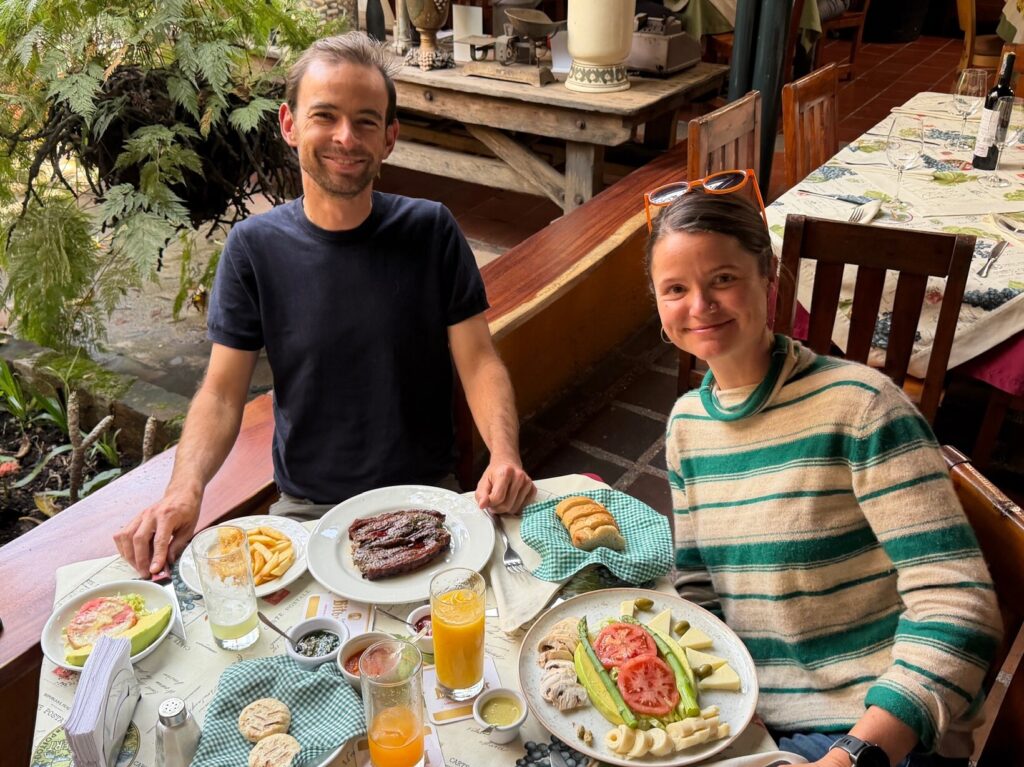Colombia has been on our radar for years, and when the time came to expand into South America—making it our sixth continent—there was no better place to start. Antarctica is the last frontier!
This guide brings together the thoughts and experiences of Beatrice and Ben to offer an insight into cycling in Colombia. With Ben, our General Manager, spending six months on the ground, he has been refining the route, inspecting hotels, and fine-tuning the details to ensure the experience meets our standards. Much of our discussion in the lead-up to this launch has focused on how perceptions of Colombia have evolved — from its turbulent past to the vibrant, safe and culturally rich destination it is today.
Beatrice’s on-the-road perspective has added another valuable layer, helping us paint a fuller picture of what cycling and travelling here truly feels like. And special thanks to Tomas, whose local knowledge, gained from more than 10 years of running bike tours in Colombia, has been instrumental in shaping the culturally immersive itinerary we have today. Together, their insights help explain why Colombia stands out as the ideal location for our first South American cycling adventure.
“Few places combine terrain, culture, and cycling heritage as naturally as Colombia. From the Andes’ high passes to the coffee country and Caribbean coast, every ride draws you into a new landscape and rhythm. Geography shapes everything here — the Andes carve through the nation’s heart, creating thousands of kilometres of roads that range from gentle rollers to lung-searing climbs. But it’s the culture that gives it soul: cycling is part of daily life, from weekend riders on the mountain passes to commuters in bustling city streets. And now, with Colombia open, safe, and welcoming, it’s the perfect time to explore it by bike.” Ben Weigl
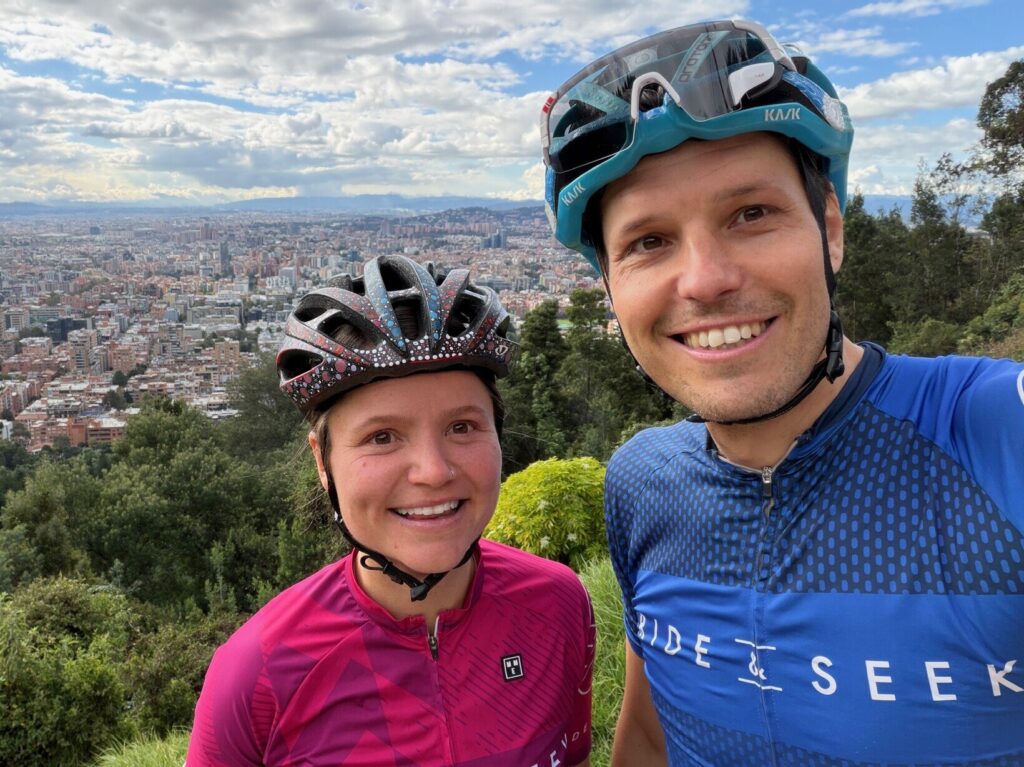
The guide presented below is designed to offer practical insight for anyone considering a cycling trip to Colombia, whether you’re planning your own route or joining us on our Bolivar Tour.
Why Cycle in Colombia?
Colombia rewards cyclists who appreciate variety. You might begin your morning at 2,500 metres (8,200 feet) in crisp Andean air, ride through cloud-forest terrain by midday, and finish the day in subtropical warmth.
The Andes dominate the interior, but the country also holds coastal plains, river valleys, and coffee-growing highlands that sit at ideal riding temperatures year-round. Many of these same routes once carried Simón Bolívar and his army toward independence — a reminder that Colombia’s landscapes have long been a stage for endurance, freedom, and determination.
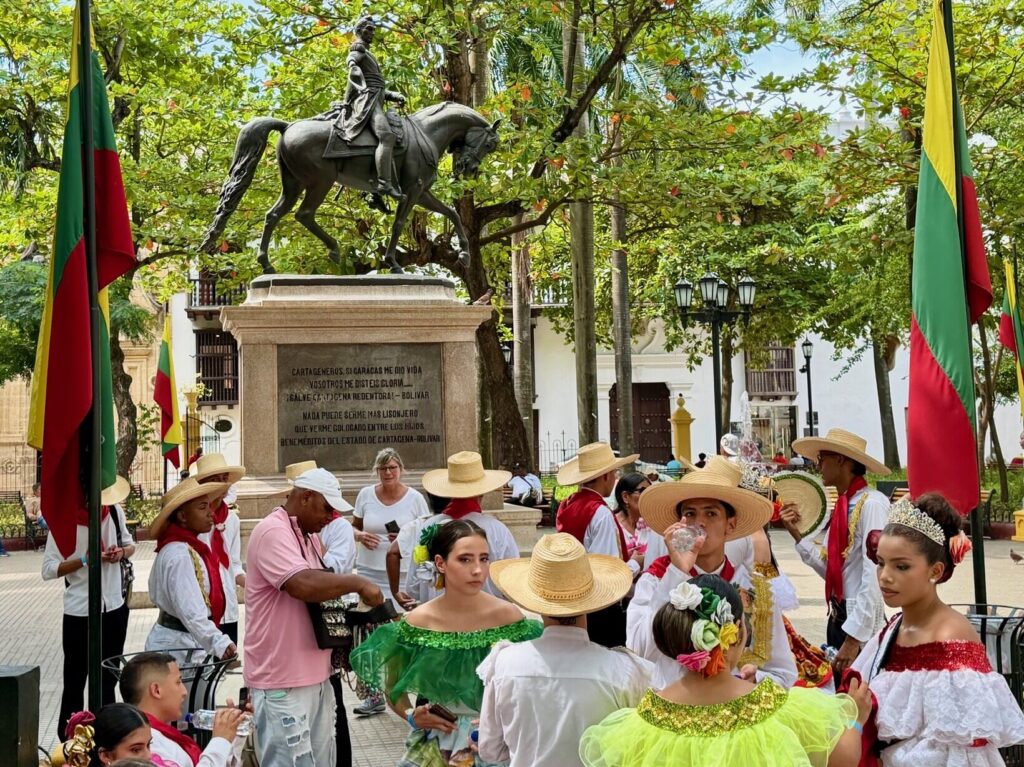
Climate is one of the most practical reasons to ride here. Sitting near the equator, Colombia experiences seasons defined by rainfall, not temperature. The dry months — November through March and July through August — bring the most consistent conditions. Even in wetter periods, rain usually arrives in the afternoon, leaving mornings clear for riding.
“But what makes cycling in Colombia exceptional isn’t just the roads or the weather — it’s the people. Colombians wave from doorways, cheer from roadside shops, and often ride themselves. There’s a shared language around the bicycle, whether you’re passing a weekend club ride or stopping for water at a tienda where the owner asks which climb you’re tackling.” Ben Weigl
Once you leave the cities, Colombia quickly becomes remote. Long stretches of mountain road thread through farming villages, coffee plantations, and valleys where life moves at a slower pace. It’s in these quieter sections that the country reveals its spirit.
“Cycling in Colombia is wonderful — the whole vibe encourages you to slow down and take it all in. You feel it in the way drivers interact with cyclists, giving space and respect as everyone gets on with their day. And if the sloth signs are anything to go by, this really is a country where you’re meant to take it slow and enjoy the ride.” Beatrice Jeavons
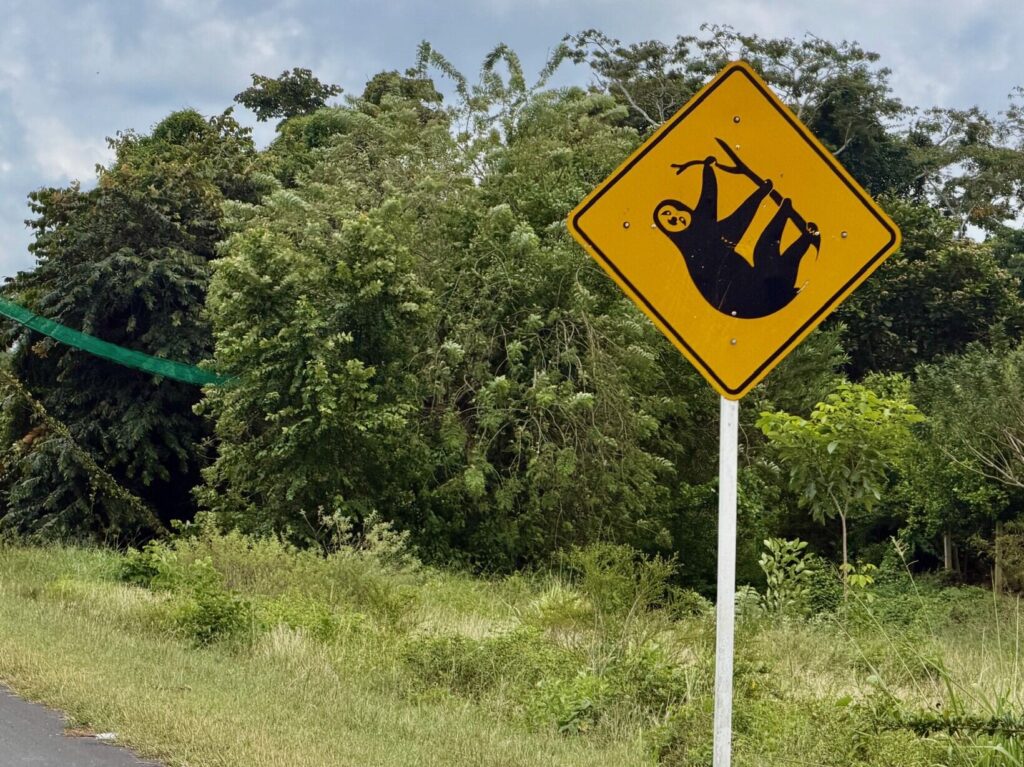
Key Cycling Regions and Tour Routes
Bogotá and Surrounds
Bogotá serves as the logical starting point for most cycling trips, and it’s where Ride & Seek’s Colombian epic begins. The city sits on a high plateau surrounded by rolling hills and peaks, and the altitude alone makes it a training ground. Every Sunday, the Ciclovía closes over 120 kilometres of city streets to cars, filling them instead with thousands of cyclists, runners, and families. It’s less a novelty and more a cultural institution.
The roads leading out of the city climb quickly. Popular routes head toward La Calera, Patios, or Guatavita, each offering expansive views once you’re above the urban sprawl.
Villa de Leyva
Two hours north of Bogotá, Villa de Leyva offers a completely different vibe. The town itself is colonial, built around a vast cobblestone plaza that seems frozen in the 16th century. The roads leading into and out of town are quiet, winding through high-desert terrain dotted with fossils, olive groves, and Andean farmland.

The Coffee Triangle
The region known as the Coffee Triangle—roughly between Manizales, Pereira, and Armenia—sits at the heart of Colombia’s coffee culture. The roads here roll through plantations, past fincas with sweeping porches, and into small towns where world-class coffee is treated with the seriousness it deserves.
The terrain is less extreme than the high Andes, which makes it ideal for soaking in the unique landscape after some more rigorous days. The climbs are steady rather than punishing, and the descents often lead directly into towns where you can stop for lunch, walk through a market, or visit a working coffee farm.
Alto de Letras
If you’re after a real challenge, the Alto de Letras more than earns its reputation. At over 80 kilometres and rising from around 300 to 3,600 metres, it’s one of the longest paved climbs in the world. The gradient is steady, the surface good, and the landscape changes endlessly as you ride — from tropical heat at the bottom to crisp, thin air near the summit. It’s become a near-mythical ascent thanks in part to features like Simon Richardson’s GCN video, and it genuinely captures the scale and atmosphere of riding in Colombia. The ‘Braking News’ though, is that there is a NEW longest climb called Alto del Sifón, and we have chosen to ride that instead of Letras on Bolivar.
Alto del Sifón
Meet Alto del Sifón — or El Sifón as locals call it. This Tolima giant stretches to about 115 km with more than 4,700 metres of gain, putting it right at the top of the list for longest paved, uninterrupted ascents. It’s not the gradient that gets you, and it’s not a tricky road; it’s the relentless length. To grasp the scale, you’re looking at a climb over four times longer than Mont Ventoux, more than twice Mount Teide, and even beyond Mauna Kea. Alto del Sifón resets the bar: a pure endurance challenge where the real battle is staying steady, patient, and mentally switched on for hours.
We’ve set the tour up so you can ride the whole climb or just a section of it, depending on how big a day you’re after. The road has been newly paved and runs through a national park, which means you can properly get away from the traffic — something Letras simply doesn’t offer in the same way. Having scouted both routes, we’re convinced Sifón is the climb for us.
Cartagena and the Coast
Cartagena makes a fitting endpoint after days in the high mountains, trading altitude and cool air for heat, humidity, and the sound of the Caribbean. It’s also a chance to explore a popular tourism destination in its own right; expect colonial architecture, Caribbean vibes, and food that reflects centuries of coastal trade.
Cartagena’s walled old town is dense with history and energy. Cobblestone streets wind between brightly painted facades, balconies spill with bougainvillea, and shaded plazas offer a place to rest with a cold drink. The city’s food scene rivals any in South America, with fresh seafood, tropical fruit, and inventive local cooking that reflects both Caribbean and Spanish roots.
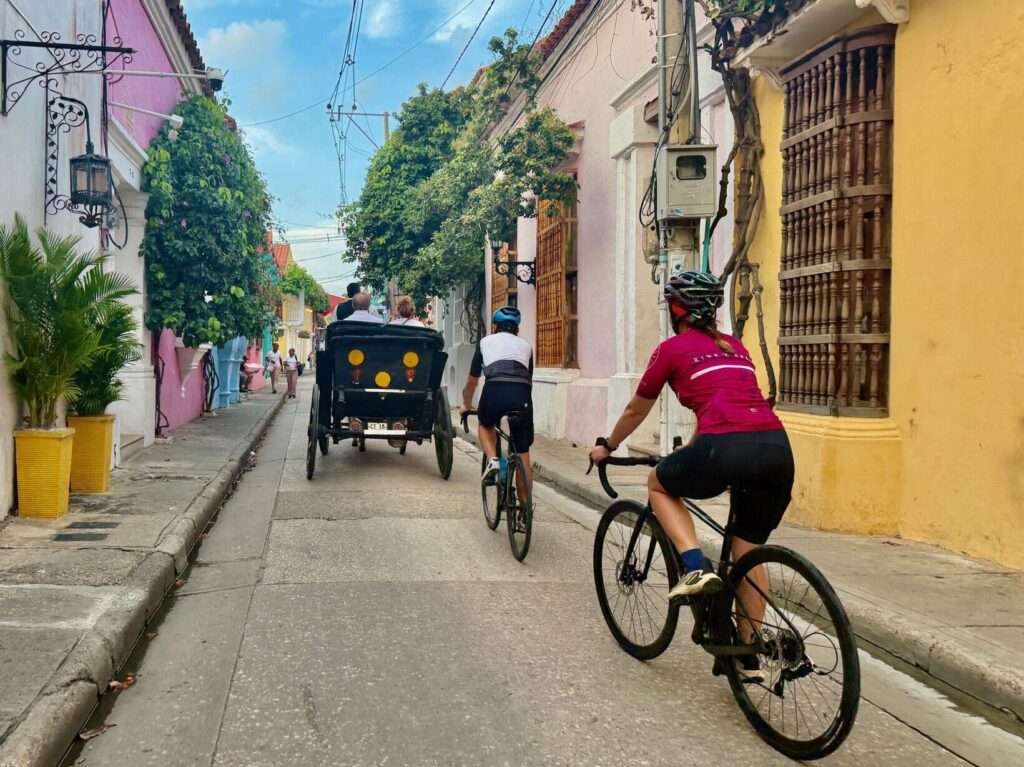
Ride & Seek’s Colombia Cycling Tour finishes here, where the country’s contrasts finally converge — mountains and coast, endurance and ease, history and celebration. Cycling through this landscape, you can still feel that same spirit of independence and pride that defines Colombia today.
Cycling Culture and Daily Life on the Road
Cuisine is a big part of what makes Colombia an unforgettable cycling destination.
Roadside vendors sell empanadas — fried pockets of dough filled with meat or potatoes — that make ideal mid-ride fuel. Arepas, the corn cakes that show up at nearly every meal, come in dozens of regional variations. Fruit is everywhere: mango, papaya, lulo, guanábana, often sold from carts or small shops along the route.
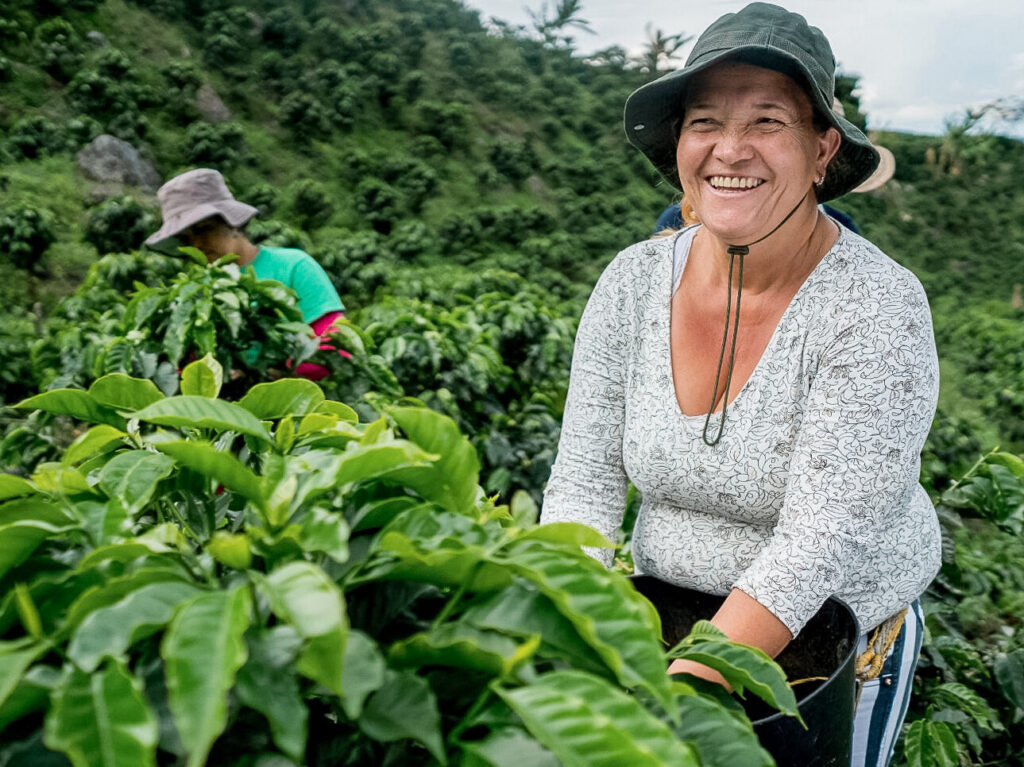
Coffee, naturally, is a ritual. Even the smallest tienda will have a thermos ready, and the quality is consistently high. It’s common to stop mid-morning for a tinto — a small, strong cup — served in a plastic or ceramic mug that you return before continuing.
Downtime between rides reveals another side of Colombia. Markets are practical rather than polished, filled with produce, textiles, and household goods instead of souvenirs. Town plazas fill in the evening as families walk, vendors set up carts, and music drifts from nearby cafés.
Safety, Infrastructure, and Local Support
Colombia has invested heavily in cycling infrastructure over the past two decades. Major roads include wide shoulders, clear signage, and regular maintenance. In tourist regions, police often patrol routes specifically to support visiting cyclists. The country’s reputation has shifted, and the reality on the ground reflects that change.
That said, altitude requires respect. Bogotá and much of the Andes sit above 2,500 meters, and even fit riders need time to acclimate. Headaches, fatigue, and shortness of breath are common in the first 48 hours. Hydration matters more at elevation, and pacing yourself on early climbs prevents unnecessary suffering later.
Local riding etiquette is straightforward. Drivers generally give cyclists space, especially on mountain roads where they’re used to sharing the pavement. Hand signals are understood, and it’s common practice to acknowledge drivers who wait patiently behind you on narrow sections.
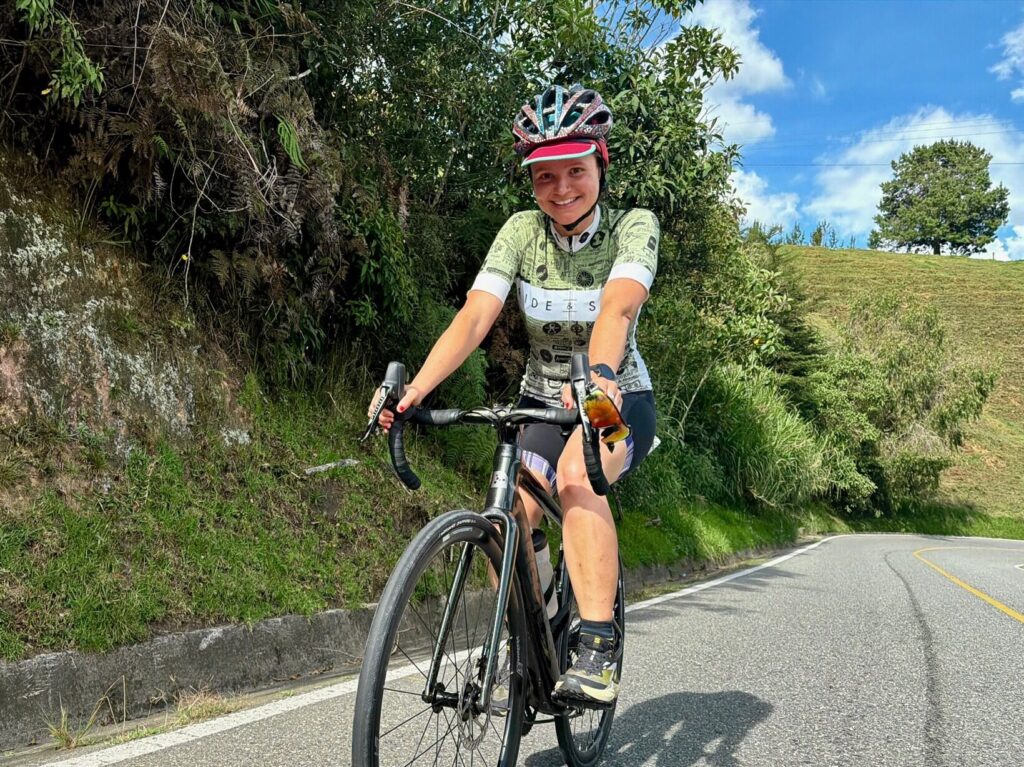
In the words of Beatrice, who is travelling in Colombia for the first time, offering a fresh and honest perspective on what it’s like to ride here, from her early impressions and favourite discoveries to the practicalities of cycling as a woman and a vegetarian.
Your favourite city or town so far, and why?
Cartagena. The energy, the colourful neighbourhoods, the Caribbean influence — it all feels alive and incredibly welcoming.
Your favourite meal?
I love the plantain that comes with so many meals here, all the amazing fresh fruit — especially green mango with salt and lime (mango biche con sal y limón) — and the soups in the menú del día. Simple, full of flavour, and perfect for replenishing salts after a hot ride.
Your favourite drink?
Definitely lulo juice. Not too sweet, super refreshing, and perfect after a long day on the bike.
What has surprised you most about being in Colombia?
How polite and respectful the drivers are. Even on busy roads they give you loads of space, offer little toots of encouragement, and shout supportive cheers out the window. Cycling is genuinely part of the culture and identity here.
How does cycling in Colombia differ from Europe or Australia, and why?
The drivers! I wish the trucks back in Australia were this polite. The roads often run straight through the heart of each village, so you find yourself riding past kids playing, farm animals, street stalls and everyday life unfolding right beside you. It feels very connected and human. And in the big cities they hold Ciclovía on Sundays, closing major roads to cars so people can ride, run, roller-skate and just be out. It’s amazing.
What’s it been like riding there as a woman?
I’ve felt completely fine and safe. Bogotá, like any big city, has areas you avoid and moments where you stay aware, but overall, the vibe has been respectful and friendly. And there are so many women out riding in the cities — it’s great to see.
How has it been being vegetarian food-wise?
Mostly pretty good. I’m a fairly flexible vegetarian, and while some smaller places have limited options, I’ve always managed to find something delicious with enough protein — as long as you’re happy with beans. In the bigger cities, there are plenty of choices. Traditional food isn’t heavy on vegetables, so a little planning helps.
What’s the terrain been like — any climbs or descents you’ll never forget?
The roads are mostly good, though there are sections with potholes, gravel and rough surfaces that need attention. The climbs are incredible. Colombia is so mountainous that you can be in the heart of a major city one moment and high above it the next, with huge sweeping views in every direction.
Any other insights?
Just how much the country has changed. The old stereotypes don’t reflect the reality on the ground — things are vibrant, colourful and far safer than the stories from 30 years ago would suggest.
When to Go and What to Expect
The dry seasons—November through March and July through August—offer the most reliable riding conditions. Mornings are typically clear, with afternoon clouds or rain appearing predictably enough that you can plan around them.
Temperatures vary by elevation, but daytime highs in the mountains range from 15 to 25 degrees Celsius, while coastal areas stay warmer. Even the rainy season can be an excellent time to immerse yourself in Colombia’s best cycling; it rarely rains all day and you’ll have less crowds on main roads and lush surrounding landscapes.
Regional climates differ significantly. Bogotá can be cool and overcast. The Coffee Triangle tends toward warm days and mild evenings. Cartagena is tropical, with heat and humidity that require adjustment if you’ve been at altitude for weeks.
Gear should account for variable conditions. Mornings at altitude can be cold, requiring arm warmers, a vest, and gloves. By midday, you’ll likely strip down to a jersey and bibs. Rain gear is essential, even during the dry season, as weather in the mountains shifts quickly. A good multi-tool, spare tubes, and a pump are standard, though mechanical support is often available on popular routes.
Planning Your Colombian Cycling Trip
Good riding in Colombia is about balance — enough climbing to make it memorable, but not so much that it overshadows the journey itself. Our route is designed with that in mind: challenging enough to satisfy strong riders, yet accessible within our three-and-a-half–espresso-cup grading. It blends steady climbs with cultural immersion at every turn, with optional extensions for those who want to push a little further.
The route was developed by our General Manager, Ben, together with our local partner, Tomás, whose knowledge of Colombian roads and riding culture shapes every stage. It reflects Ride & Seek’s Epic Bike Tour approach: purposeful, immersive, and connected to place.
The result is a journey that celebrates stunning landscapes, warm hospitality, and the simple joy of exploring one of the world’s great cycling nations.
Frequently Asked Questions About Cycling in Colombia
Tomas (pictured above) has played an instrumental role in helping us shape an itinerary that we believe offers the best cycling and travel experience we could provide in Colombia. Drawing on his insight, he also helped us respond to some of the key questions that have come up in the lead-up to creating this tour.
Is it safe to cycle in Colombia?
Yes. Cycling in Colombia is generally safe, especially in areas popular with riders and on established routes. The country has invested heavily in road infrastructure and cycling awareness. Many Colombians use bicycles for daily transportation, and drivers are accustomed to sharing the road. As always, local knowledge helps — guided tours or recommended routes ensure the safest and most rewarding experience.
How popular is cycling in Colombia?
Cycling isn’t just a sport in Colombia — it’s part of the national identity. From everyday commuters to elite Colombian cyclists who dominate international races, the passion runs deep. Cities like Bogotá host weekly Ciclovía events, closing major streets to cars so thousands can ride freely. The sport’s success on the world stage has made cycling one of Colombia’s most prestigious and unifying activities.
Why cycle in Colombia?
Cycling is one of the best ways to explore Colombia’s diversity — from the Andes to the Caribbean coast. The combination of smooth roads, stunning scenery, and warm hospitality makes it a truly unique riding destination. Whether you’re seeking a challenge or a cultural journey, exploring by bike is the way to go if you want to see the real Colombia.
Ready to plan your epic Colombia cycling trip? Get in touch today.
